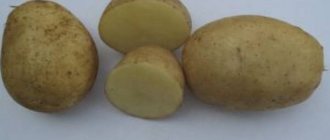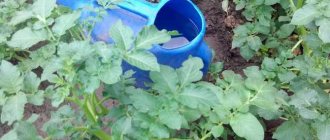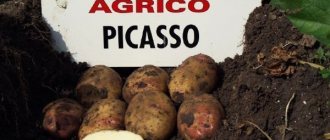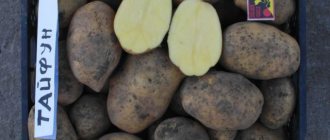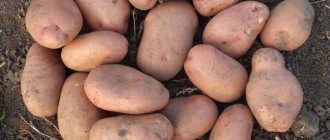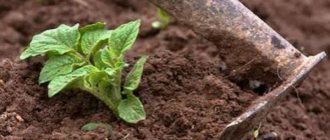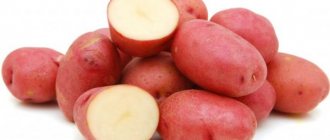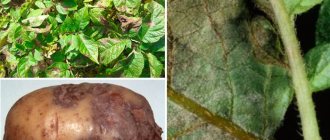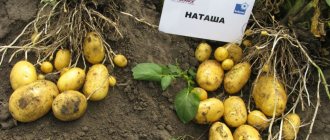Signs of potato damage
The disease is distinguished by certain symptoms. If you identify them in time, you can prevent the spread of infection and preserve a healthy part of the crop. Potato tubers are covered with growths that are similar to the shape of cauliflower. As a rule, they appear from ocelli. The size can vary from a few millimeters to tens of centimeters.
The growths on the potato tuber at the beginning of the disease have a light yellow tint. Over time, the color changes to dark brown. The infected fruit disintegrates and rots. In rare cases, they appear between the lower leaves and stems. If the roots remain untouched, this means that the disease affects young tissue.
Signs of the disease may vary depending on climatic conditions. If they are unfavorable, the leaf-like growths are shaped like a pine cone. The top is covered with small hard crusts, similar to scab. The corrugated form of infection leads to the fact that the tubers become wrinkled, the potato skin becomes covered with depressions, ridges and waves.
The causative agent of the disease
The development of the disease occurs under the influence of a pathogenic fungus. Its name is Synchytrium endobioticum (Schilb.) Perc. In addition to the potato tuber, it also parasitizes tomatoes, wild nightshade and physalis. In this case, the fungus attacks the root system of crops.
Features of the pest
The fungus cannot survive drought or cold. Therefore, there is no potato cancer in the southern and northern regions. In the first case, over a long period of time, the soil warms up to +30 °C to a depth of 10 cm. In the second, it freezes to -11 °C.
Overwintering of the pathogenic fungus in the soil occurs in the form of zoosporangia. They are cysts covered with a durable membrane. In spring they transform into zoospores. Zoosporangia tend to live in the soil for 30 years, waiting for suitable conditions.
For the fungus to fully develop, the soil temperature should be in the range from +15 to +18 °C. At the same time, the humidity is not less than 80%. The same conditions must exist for normal potato growth. Most zoosporangia are formed from June to July. Just when the potato tuber is forming.
Features of distribution
Potato cancer was first identified in 1888. Today, this disease has spread throughout almost the entire territory of Europe. The disease is least common in America, New Zealand and Africa.
In our country, potato cancer has already been noticed in many regions where this crop is grown. Plants planted in garden plots are especially susceptible to this disease. Crops from the southern and northern regions are least susceptible to cancer.
It is worth noting that the disease spread throughout Russia during the Great Patriotic War. The fungus can affect not only potatoes. Such microorganisms can ruin the harvest of peppers, beets, eggplants, tomatoes, and so on.
Sources of infection
A pathogenic fungus can enter a potato plot in several ways:
- melt water in spring;
- manure from animals fed raw potato fruits;
- through instruments used in the quarantine zone;
- gardener's shoes and clothing;
- the fungus is carried by insects and earthworms;
- diseased potato tubers acting as planting material.
Earthworms are able to live deep in the layers of soil. They act as the main carriers of the fungus. The causative agents of the disease are found at a depth of 50 cm from the surface of the earth. Such cases occur quite often.
The intracellular organism that causes the disease is highly resistant to external conditions. That is why the source of infection can be stored in the ground for 30 years. Dry weather slows down the development of the fungus; some zoospores die as a result of lack of moisture. Due to its viability, the fungus is dangerous and harmful to potatoes.
How the disease spreads
Potato blight is a disease that spreads quickly. In order to promptly identify the disease, you need to know how healthy plants are infected. The following factors contribute to the spread of the fungus:
- already infected tubers are present;
- tubers and seedlings were grown in the affected area;
- the contaminated soil was brought onto the site along with household tools that contained clods of soil with a parasitic fungus.
Potato cancer often occurs in cases where the crop has been grown in the same place for many years. A fungus that attacks root crops can be brought into the area along with rain and melt water. Manure is also of particular importance. If cattle were fed infected raw potato tubers, the pathogen may also get into the fertilizer. In a separate area, the fungus can be introduced along with planting material.
Fighting methods
If at least one infected tuber is found on the site, you should immediately notify the plant protection inspectorate. To prevent zoosporangia from getting into manure, diseased potatoes are not fed to animals. Bushes that are affected by cancer are burned along with the tops and tubers.
To get rid of them, they throw them into a deep hole, sprinkling bleach on top.
Diseased root vegetables do not pose a danger to humans, but still they should not be eaten.
Agricultural technology
Every year, in the spring, part of the sporangia becomes active. As a rule, only 30% of pathogenic fungi can withstand winter cold. The essence of agricultural techniques is to open as many cysts as possible. Zoospores that do not find a host die.
To achieve this, use the following methods:
- In the spring, before planting potatoes, fertilize the area. At least 300 kg of manure is used per 1 hectare of land. Disinfection of soil in a greenhouse occurs under the influence of urea. For 1 sq. m is 1.5 substances.
- The plot of land where potatoes grew last year is planted with corn. The root system of the crop secretes a special substance that promotes the release of zoospores. Legumes and rye are considered good soil “cleaners.”
- Planting potato varieties resistant to fungus.
In fact, vegetables are highly susceptible to the effects of zoospores. The affected cell is deprived of the ability to feed the parasite and dies over time. The tissue around it hardens, forming a pustule that contains the dead pathogen. Healthy tissue pushes out the pustule, and the wound heals.
The soil can be completely cleared within 6 years by planting potato varieties that are not susceptible to fungal attack. At the same time, the variety is changed every 4 years to eliminate the possibility of potato cancer adapting to it. It is under no circumstances recommended to sow infected areas with Blue-Eyes and Lorch. They have special sensitivity to the pathogen.
Related article: Folk remedies for late blight in tomatoes and potatoes - review
Before planting the planting material, it is soaked in a 0.5% Benomyl solution, another name is Benleint. As an alternative, take a 1% solution of Fundazol. To destroy the source of infection, the ground is watered with pesticides. For 1 sq. m take 20 liters of Nitrophen.
Such actions represent a real chemical operation that should only be performed by a specialist. After applying chemicals, the land is unsuitable for growing any crops. Potatoes or any other vegetable are planted after 3 years. This method of fighting fungus is considered the most extreme of all existing ones.
Which varieties are resistant to fungus
Planting and growing potato varieties that are resistant to the cancer pathogen helps stop the spread of the fungus. In addition, such plants help to completely clear the soil of fungus in about 5-6 years. Potato varieties with varying levels of resistance to the disease cannot be grown in infected areas. Experts recommend changing varieties approximately once every 5 years.
Among the domestic varieties, the most resistant to the cancer pathogen are:
- Falensky, Iskra, Early yellow, Borodyansky and so on. All of these varieties give an early harvest.
- As for domestic mid-early varieties, when choosing them it is worth giving preference to such varieties of potatoes as Ogonyok, Lvovsky Bely, Stolovy 19, Smachny, Zorka.
- Among the mid-late ones, Viliya, Candidate, Loshitsky, Sulev, Pavlinka and so on stand out.
Prevention
Disinfecting an area is a difficult process that requires time and effort. To avoid contamination of a land plot, you must:
- Remove weeds from the potato bed and around the area.
- Maintain crop rotation, not planting crops in the same place every year in a row. You can plant the vegetable in the same place after 4 years.
- Do not buy planting material in the place where the infection occurred. The same goes for manure.
- Do not plant any crops that belong to the nightshade family close to potato beds.
- If you still cannot avoid infection, plant cancer-resistant crops the next season.
The fungus that causes potato cancer is incredibly resilient. Not every living organism has such properties. For this reason, experts do not recommend planting potatoes of the same variety in the area where the infestation occurred.
Be sure to use different planting material. The agricultural crops market offers a wide range of potato varieties that have good protective properties of the immune system.
Gardeners who have had to deal with potato cancer should adhere to the rules of combating the disease. Under no circumstances should you use chemicals yourself. Especially when it comes to garden or summer cottage plots. The procedure for eliminating fungus is carried out exclusively by experienced people. The fungus that provokes the development of potato cancer is quite dangerous and requires immediate action on the part of humans.
In conclusion
Even a novice vegetable grower should know the main signs of potato cancer. This will allow plant diseases to be identified in a timely manner and reported to the appropriate services. It is impossible to cope with the disease on your own. The infected area must be quarantined.
It is worth noting that preventive measures help to avoid loss of yield of potatoes and other vegetables on a personal plot, as well as in crop fields. If crop rotation is observed, soil contamination occurs extremely rarely. In addition to following the sowing rules, many resort to other preventive measures. A special role is played by the potato variety, as well as the choice of fertilizers.
What is it and possible dangers
Potato cancer is one of the most dangerous diseases known in agronomy. This is due to the fact that the entire crop is quickly infected, first potatoes, then other plant crops - beets, peppers, tomatoes and eggplants. It is caused by a fungal pathogen that settles on the stems or leaves, gradually destroying the plant.
The disease is not dangerous for humans, even after eating potatoes. Despite the fact that in many sources, representatives of health authorities do not recommend consuming non-marketable tubers, there is no exact ban on this. Meanwhile, in developed countries there is a fight against vegetables contaminated with cancer. It is being liquidated and prohibited from being distributed.
Signs of the disease
Dangerous tuber damage can be recognized by the following signs:
- the appearance of growths on the crop that have an unpleasant appearance;
- the formation of wrinkles with small indentations.
The main symptom is growths. At the first stages of fungal infection, they have a light yellow tint, gradually turning brown, then black. The foci of the disease are stems, leaves and the crop itself. Having reached the final stage of the disease, the growths disappear.
A common cause of damage by the pathogen is keeping the crop in unfavorable conditions - with humidity more than 55% and air temperature exceeding 22 degrees. There are also several reasons associated with poor crop care:
- growing tubers in a shaded place;
- missing, insufficient or incorrect soil fertilization;
- use for sowing seeds of low quality, not resistant to cancer.
Infection occurs instantly. The pathogen infects the plant from top to bottom - first the green mass, and lastly the root system and fruit. The disease quickly spreads to neighboring plant crops, gradually filling the entire garden.
Pathways and sources of pathogen
Oncological disease is formed from the influence of a pathogenic fungus, which penetrates a healthy bush from contaminated soil, thawed water, boots or clothes of an agronomist, tools, or from diseased tubers.
Often, potato cancer occurs when it is planted in the same place for several years in a row. Renew the soil from time to time or choose a new place to plant your crops. At the same time, during dry periods it progresses less, since for this it needs increased moisture.
Foreign varieties
Not all potato varieties are able to resist the causative agent of plant cancer. Among the domestic varieties with a high rate of resistance against cancer, it is worth highlighting Lorch, Ulyanovsky, Tulunsky, Kemerovo, Rozovy, Priobsky, Ermak, Volzhanin. The listed potato varieties are immune to the disease. Plant cancer practically does not affect them.
The most popular foreign potato varieties among gardeners are Arosa, Rosara, and Bellarosa. They are resistant to the plant cancer pathogen. Such varieties can be grown in any region. The main thing is to know when to plant potatoes and what fertilizers to use.
Varieties of potato cancer
If you study the photo and description of cancer, you can distinguish several of its classifications depending on the type and location of the lesion:
- neoplasms on a loose structure – the main type;
- the appearance of growths on the leaves that have the shape of a flattened cone;
- the appearance of wrinkled sagging with small depressions inside, a distinctive feature is wavy edges;
- scabby form of the disease, a typical sign is a neoplasm in the form of plaques.
Each type of disease has an identical danger - cessation of growth or death of the plant crop. Moreover, they are all harmless to people or animals. The method of treatment for them is no different.
Methods to combat the disease
Start treatment immediately after the first signs of the disease appear - the presence of growths on the plant crop. This will help prevent the progression of cancer and save the harvest. Two measures to combat potato cancer, based on land work or the use of chemicals, are effective.
Agrotechnical methods
The method of stopping the progression of the pathogen is carried out in the fall. Then, after hibernation, before planting the crop in open ground, a small part of the pathogenic fungus will remain active. To protect the plant, do:
- In the place where the potatoes sprouted, deepen the seeds of corn, rye or beans. They help destroy spores.
- In the spring, neutralize the soil by fertilizing it with urea in the form of granules.
Related article: Box for storing potatoes in winter in the cellar and on the balcony
The agrotechnical method allows you to eliminate the pathogen and make it inactive before planting the seed in open ground. In the next 1-2 seasons, the tubers will be protected from the pest.
Chemical methods
An effective measure to eliminate pathogenic fungi from planting tubers and prevent its damage from the soil is treatment with the drug. To do this do:
- Pour the prepared Benomyl or Fundazol solution into a deep container.
- Place the tubers in it. Leave to process for 30 minutes.
The disease can be eliminated by treating the soil with Nitrophen. It is necessary to call an agronomist who can better cope with this task, since the procedure is dangerous for humans; working with potent poisons can lead to poisoning or burns of the respiratory tract. After cultivating the land, do not plant crops in it for 3 years.
Prevention
Prevention measures that prevent the development of potato cancer include the following measures:
- Regular inspection of plant crops. Removal or transplantation of seedlings to a remote location immediately after detection of neoplasms.
- Planting in open ground only those seedlings that are resistant to the appearance of growths. These include varieties such as “Yellow Early”, “Zorka”, “Iskra”, “Ogonyok”, “Candidate” and “Smaki”.
- Creating a favorable climate for growing potatoes and feeding them in a timely manner.
If you suspect tuber crops are infected with a pathogenic fungus, call a specialist agronomist to your garden. He will confirm or deny the fact of the disease, determine its type and select the most effective method of treatment.
Raisa
I’ve been growing potatoes since childhood, first with my parents, then alone, and I’ve never had a problem with it. But, 2 years ago, I dug up the tubers and discovered that in one area I began to see unpleasant-looking tubers with growths. I sent it for examination - it turned out to be cancer. I immediately threw out all the infected tubers; I didn’t dare use them for cooking. Due to inexperience, I planted a crop in the same place and last year, as a result, most of it was also damaged. If a disease is detected, I recommend changing the planting site and sowing rye in the old ridge to combat the pathogen.
Agatha
Last year I noticed that most of the potato bushes were affected. After studying the encyclopedia on agronomy and studying photos of each species, I realized that it was cancer. Naturally, the tubers were also damaged and unfit for consumption. I recommend carefully selecting planting material before deepening it and taking care of the plant crop, then there will be no problems with the harvest.
Potato cancer is a common disease in all regions, contributing to a decrease in quantity, a decrease in quality, or the complete elimination of the crop. With proper planting, proper care and compliance with preventive measures, its occurrence can be avoided. If, nevertheless, the pathogen has infected the plant crop, then take agrotechnical or chemical methods to combat them.
Potato cancer: description of the disease, methods of control and prevention
When growing vegetables, and especially potatoes, you can encounter diseases such as cancer. Yes, plants can also get sick from it. The causative agent of this pathology is a special fungus belonging to the class of biotrophic microorganisms.
This disease is of quarantine type, and can cause either a slight loss of yield or its complete destruction. Let's look at this problem in more detail, find out how it manifests itself, how you can fight it, and how to prevent it.
Potato cancer - description
This insidious potato disease was first discovered in 1888. Nowadays, potato cancer can be found almost all over the globe. But, most often it is detected in Europe, less often in the USA, Africa and New Zealand.
In Russia, this fungus can be detected by gardeners in all regions. It is especially “active” in small areas near houses. In the northern and southern parts of our country it is less common.
The danger of potato cancer
Potato cancer is absolutely not dangerous for humans. Moreover, in our country and some other CIS countries, even contaminated potatoes are considered a harmless product. It can even be sold, although it deteriorates very quickly and is, to put it mildly, “not marketable.”
If you think carefully, you still shouldn’t buy potatoes infected with cancer, much less eat them. Health authorities officially give such recommendations, although there is no absolute prohibition.
In other European countries, there is an active fight against cancer-infected vegetable crops - they are increasingly being eliminated in order to prevent the massive spread of the disease. But, it is not prohibited to plant it over long distances.
Signs of infection
Potato cancer, like any other disease, has a pronounced “clinical picture” and symptoms by which it can be “diagnosed” in order to prevent spread to healthy crops.
The first sign is the covering of potatoes with growths of a “disgusting” appearance. They sprout from the eyes, and may somewhat resemble cauliflower leaves. The size of the “tumors” can range from a couple of millimeters to several tens of centimeters in length.
In conditions conducive to cancer development, plants will develop growths that look like leaves or resemble pine cones. Crusts may also occur, which can be confused with scab.
If the form of potato cancer is corrugated, then the fruits will have very noticeable “wrinkles”; deep depressions, “swells”, depressions and other deformations can be seen on them.
Causes
In order for a bush to become infected with cancer, and for the latter to begin its active “capture” of the upper crop system, it needs increased soil humidity - about 55-75%, and a constant temperature of about +22 degrees. The main source of potato cancer is cysts that exist in the soil, as well as root crops that have already been “attacked” by the disease.
Related article: Potato rhizoctonia (black scab) - causes and prevention
Also, among the secondary, but no less common causes of cancer include:
- Small crop rotation;
- Poor fertilization of the soil before planting;
- Cultivation of potato varieties that are not resistant to cancer;
- Use for sowing seeds of unknown origin;
- “Compliance” with favorable conditions for the development of the disease.
As we have already written, except for potatoes, almost all vegetable crops can become infected with cancer. But the disease can also negatively affect nightshade crops. In the case of the latter, the root system of the bush will also be affected.
The pathogenicity of this type of cancer is quite high. Moreover, it does not matter at all what type of cancer is spreading in the garden. Still, the yield may fall to the lower limit. Moreover, if you store “cancerous” tubers next to healthy ones, then both will rot as quickly as possible.
How Cancer Spreads
To quickly determine the source of cancer, you need to understand exactly how its causative agent, the fungus, spreads. Thus, the main ways of spreading potato cancer today are considered to be:
- Potatoes already affected by the disease. The harmful disease can also spread from seedlings and root crops that previously grew in an infected field;
- The disease is also contained in the soil, which comes into contact with various household equipment and “tools” used in the garden. Shoes also include them;
- Potato bushes are most susceptible to cancer “attack” if they are constantly planted in the same place;
- Snow or rain can also introduce infection. This factor cannot be influenced, but it can be prevented by systematically and correctly fertilizing the fruits and soil;
- If animals were fed diseased fruits or raw potatoes, then their manure can also become a source of cancer spread when fertilizing the soil;
- Seed material that was previously infected with potato canker is one of the most common causes of crop failure due to the occurrence of potato canker.
The parasitic organism that causes cancer operates inside the plant cells. It is very resistant to external conditions, and can maintain its vital functions for 30-40 years.
During dry periods, the crayfish fungus will not develop as quickly, since it needs increased soil moisture. That is, the mushrooms will simply die. And during the rains, the disease can begin to seriously progress.
Because of this vital activity, potato cancer can be considered one of the most persistent and dangerous diseases that can affect vegetable crops.
The danger of potato cancer
The disease is also dangerous for humans. Infected vegetables lose their marketable appearance and are not suitable for consumption.
How Cancer Spreads
Potato cancer is shown in the photo. There are many reasons for the spread of the disease, the main ones being:
- cysts in the soil;
- moist soil;
- non-compliance with crop rotation;
- infected root vegetables;
- growing unresistant varieties.
Please note: cancer can be spread throughout the area by meltwater or manure.
Methods to combat the disease
In order not to be afraid for your crop, and not to expose it to the risk of infection with potato cancer, you should constantly fight the disease (especially if it was noticed on the site earlier). Here are the most relevant and effective of them:
- Always check the seed material. Do not buy it from untrusted places, and never use one that is visually damaged;
- Consider all the subtleties and nuances of crop rotation on your site. The rotation of planting crops must be strictly observed. This will significantly reduce the risk of pathogenic fungus;
- Choose special potato varieties for planting, which the breeders initially “hardened” against the possibility of cancer infection;
- Never plant crops on soils whose “health” you are not sure of, and especially on those that are definitely “sick”;
- Pay maximum attention to cleaning garden tools, shoes, equipment, etc.
Regarding crop rotation. To reduce the risks, you need to plant plants such as corn, cabbage and cereals in the ground before potatoes. They help cleanse the soil and significantly reduce the risk of cancer.
You should not plant onions, cibul, etc. in the middle of the field, as they can easily become infected and then contribute to the further spread of the disease. All lands on which potatoes will be planted must be at least 1 km away. from such fields.
Boric acid is an excellent method of fighting cancer. They need to process all tubers planted in the garden. Also, fertilizers based on organic matter and minerals are suitable for these purposes. They will increase productivity, speed up the growth process of bushes, and increase their resistance to disease.
Each field with vegetable plantings must be systematically inspected. If diseased tubers are found, they are immediately removed along with the bush, buried to a depth of 1 m in the soil, having previously been treated with chlorine.
If an area is discovered where most of the bushes are infected with potato cancer, then it needs to be quarantined. At the same time, you must strictly follow all quarantine rules:
- Do not take diseased potatoes anywhere, do not sell them, do not eat them, and do not use them as planting material;
- You cannot use (for any purpose, even for “non-vegetable” crops) manure from animals that previously fed on diseased tubers;
- It is necessary to promptly report the discovery of a contaminated area to special agricultural authorities that are responsible for this;
- Do not use treatments based on strong chemicals on the soil. Of course, if you have not encountered such a problem before and you managed to solve it with their help;
- Do not grow potatoes in an infected area for at least 6 years, giving preference to crops that are not affected by potato cancer.
Choosing a landing site
Measures to combat potato cancer are completely different. The most important thing is not to plant bulbous plants in areas with damaged soil. This will only worsen the situation and speed up the spread of the fungus. Household and production plots are usually located at a distance of one kilometer from fields with potato seed crops.
To reduce the risk of infection of planting material, it is recommended to treat the tubers with a solution of boric acid. The use of fertilizers when planting potatoes in the spring is also important. It is usually recommended to use mineral mixtures that disinfect the soil and increase yield. Organic supplements are also suitable. Properly selected fertilizer will reduce the risk of plant infection and improve the germination of tubers.


